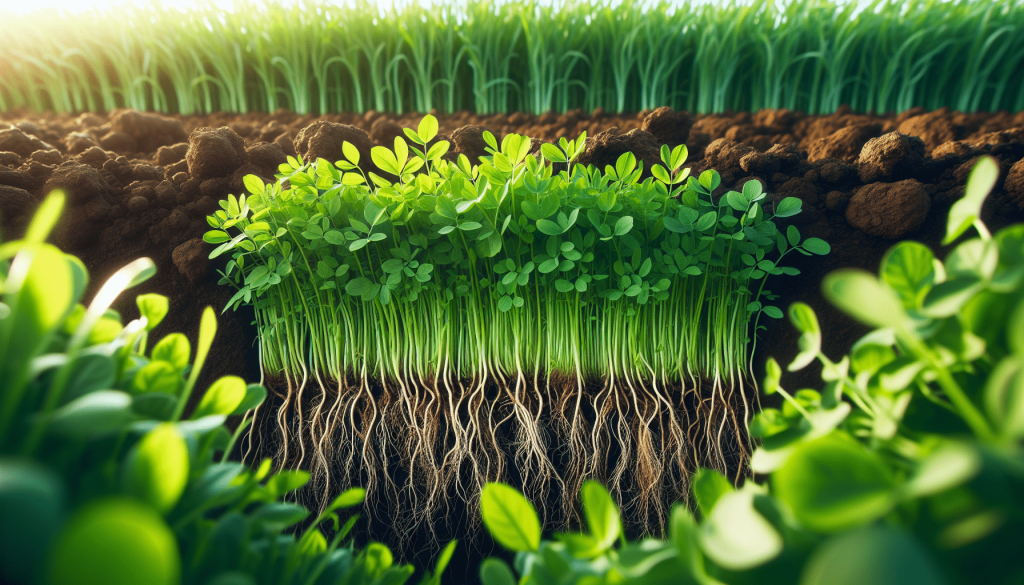This post may contain affiliate links. As an Amazon Associate, we may earn commissions from qualifying purchases.
How can I effectively use green manures to improve soil fertility?

Understanding What Green Manures Are
Green manures are plants or crops that you grow specifically to improve soil fertility. These plants are not harvested for consumption; instead, they are incorporated back into the soil to increase organic matter, improve soil structure, and enhance fertility. This sustainable approach leverages natural processes to enrich your soil, thus promoting healthier plant growth.
Benefits of Green Manures
using green manures offers a multitude of benefits that go beyond merely improving soil fertility. Let’s break down these benefits into more manageable points:
- Soil Fertility: Green manures add organic matter to the soil, which, in turn, boosts its fertility.
- Weed Suppression: These plants compete with weeds for nutrients, sunlight, and water, thereby reducing weed growth.
- Erosion Control: By covering the soil, green manures help prevent erosion from wind and water.
- Soil Structure: The roots of these plants break up compacted soil, improving aeration and water percolation.
Types of Green Manures
Understanding the types of green manures can help you select the best ones for your needs. Green manures generally fall into three categories: legumes, grasses, and broadleaf plants.
Legumes
Legumes are particularly beneficial because they fix nitrogen from the atmosphere, enriching the soil.
- Examples: Clover, vetch, peas, beans
- Benefits: Nitrogen fixation, soil structure improvement
Grasses
Grasses are excellent for quick biomass production and for improving soil organic matter.
- Examples: Rye, barley, wheat, oats
- Benefits: High biomass, erosion control
Broadleaf Plants
Broadleaf plants are versatile and often help in breaking up soil compaction.
- Examples: Mustard, buckwheat, radishes
- Benefits: Quick growth, soil compaction alleviation
Selecting the Right Green Manure for Your Needs
Choosing the appropriate green manure involves considering factors such as your climate, soil type, and the specific benefits you aim to achieve.
Climate Considerations
Different plants thrive in different climates. For instance:
- Cool-Season Crops: Rye, vetch, and clover are great for cooler climates.
- Warm-Season Crops: Buckwheat and cowpeas prefer warmer temperatures.
Soil Type
The soil type can also influence your choice.
- Sandy Soils: Choose green manures that add organic matter, like clover.
- Clay Soils: Use deep-rooted plants like radish to break up compaction.
Crop Rotation and Soil Needs
Integrate green manures into your crop rotation plan based on the nutrient requirements of your succeeding crops.
| Desired Outcome | Recommended Green Manure |
|---|---|
| Nitrogen Fixation | Vetch, Peas, Clover |
| Weed Suppression | Rye, Buckwheat |
| Erosion Control | Grasses like Barley, Oats |
| Soil Decompaction | Radish, Mustard |
Timing Your Green Manure Crops
The timing of planting and incorporating green manures is crucial for maximizing their benefits.
Planting
You’ll need to synchronize planting based on your main crops:
- Before Planting Main Crop: Sow green manures several weeks to months before planting your main crop. This allows them to grow and provide the needed benefits.
- After Harvesting Main Crop: Grow green manures immediately after harvesting to protect and enrich the soil during the offseason.
Incorporation into Soil
Incorporating green manures back into the soil is a critical step. This can be done through several methods:
- Tilling: Tilling helps in quickly incorporating the green manure into the soil. However, this can sometimes disrupt soil structure.
- Mowing and Mulching: Cutting down the green manure and leaving it to decompose naturally adds organic matter without disturbing the soil.
Practical Steps for Implementing Green Manures
Implementing green manures effectively involves several steps, from preparation to monitoring.
Preparation
- Soil Testing: Conduct a soil test to determine nutrient levels and pH.
- Site Selection: Choose areas where green manures can grow without affecting other crops.
Planting
- Seed Selection: Select high-quality seeds of the green manure species best suited to your needs.
- Sowing: Depending on the plant type, you can broadcast seeds or plant them in rows.
Monitoring
- Growth Monitoring: Keep an eye on the growth of green manures to ensure they are thriving.
- Pest and Disease Control: Although green manures are generally hardy, keep an eye out for pests and diseases that might affect them.
Incorporation
- Timing: Plan to incorporate the green manure at the peak of its growth stage.
- Method: Choose the most appropriate incorporation method based on your soil conditions and desired outcomes.

Common Challenges and Solutions
Like any agricultural practice, using green manures comes with its set of challenges. Let’s look at some of the common issues and how to resolve them.
Weed Competition
Green manures can sometimes compete with weeds instead of suppressing them.
- Solution: Choose aggressive, fast-growing green manures that can outcompete weeds.
Poor Growth
If the green manure does not grow well, it won’t provide the intended benefits.
- Solution: Ensure that the green manure is suited to your soil type and climate. Monitor soil fertility and moisture levels regularly.
Disease and Pest Issues
Although green manures are generally resilient, they can still suffer from diseases and pests.
- Solution: Rotate different types of green manures and main crops to break pest and disease cycles.
Integrating Green Manures with Other Sustainable Practices
Green manures are just one part of a broader sustainable agriculture practice. Here’s how you can integrate them with other techniques:
No-Till Farming
Combining green manures with no-till farming can significantly improve soil structure and organic matter content.
Composting
Incorporate composting with green manures to further enhance soil fertility.
Cover Cropping
Use green manures as part of a cover cropping strategy to protect and enrich soil during fallow periods.
Case Studies and Real-world Examples
Sometimes, the best way to understand the benefits and implementation of green manures is through real-world examples.
Small-scale Organic Farm
A small-scale organic farm used a combination of clover and vetch as green manures. This not only improved soil fertility but also reduced their reliance on commercial fertilizers.
Large-scale Agricultural Operation
A large-scale agricultural operation implemented rye and mustard as green manures. This practice resulted in a 20% increase in soil organic matter over five years, improving overall crop yields.
Frequently Asked Questions
How long do green manures take to grow?
Green manures can take anywhere from a few weeks to several months to grow, depending on the type.
Can I grow green manures during the winter?
Yes, many green manures like winter rye and hairy vetch are suitable for winter growing.
Do green manures attract pests?
While green manures can attract some pests, their benefits generally outweigh this drawback. Rotating different types of green manures can help mitigate this issue.
Conclusion
Using green manures is a highly effective way to improve soil fertility, enhance soil structure, and promote sustainable agriculture. By selecting the right type of green manure suited to your climate and soil conditions, you can harness the natural power of plants to enrich your soil, making it more productive for future crops. Through proper planning, monitoring, and incorporating green manures into your farming practices, you’ll achieve healthier soil and more bountiful harvests.








